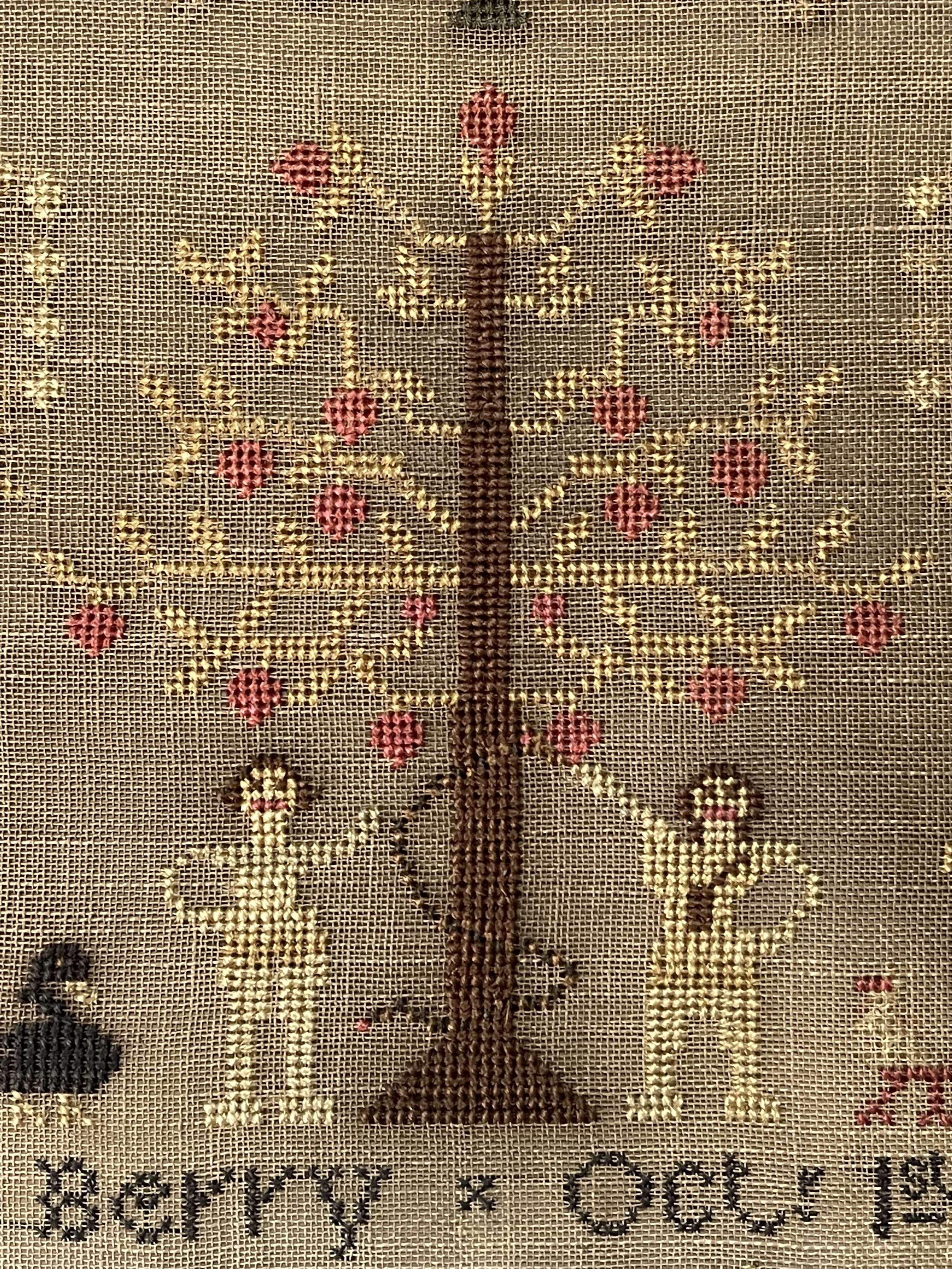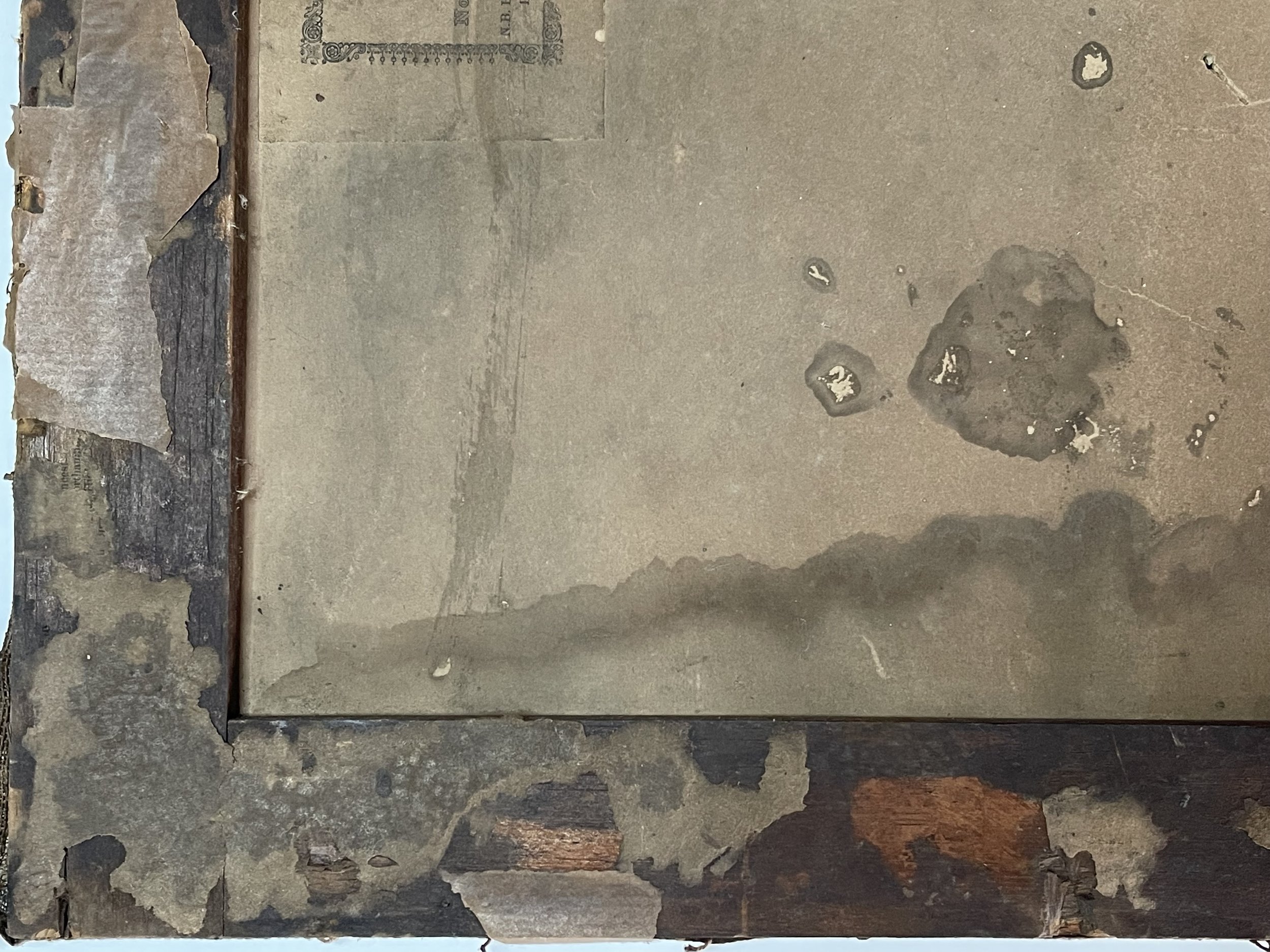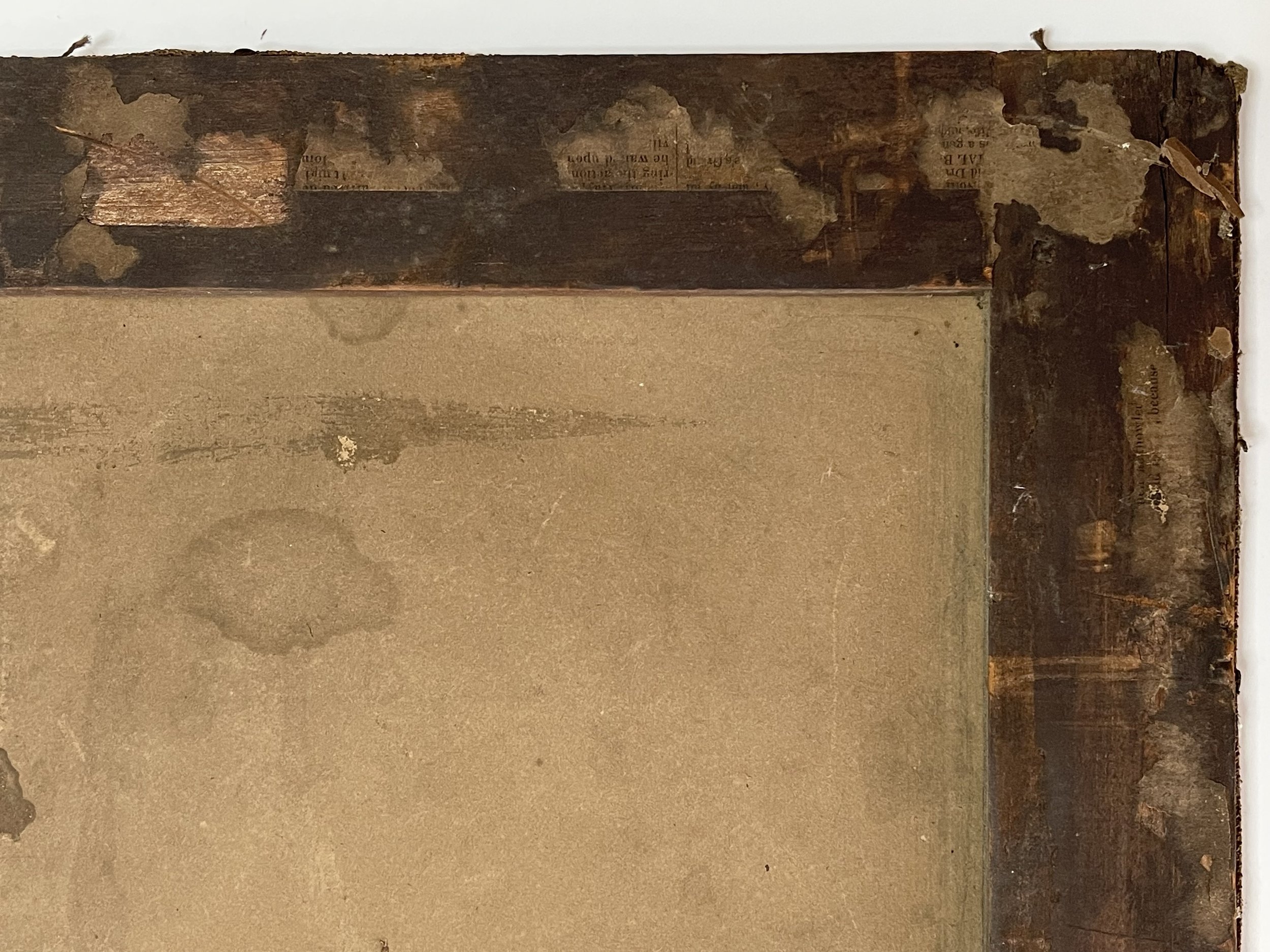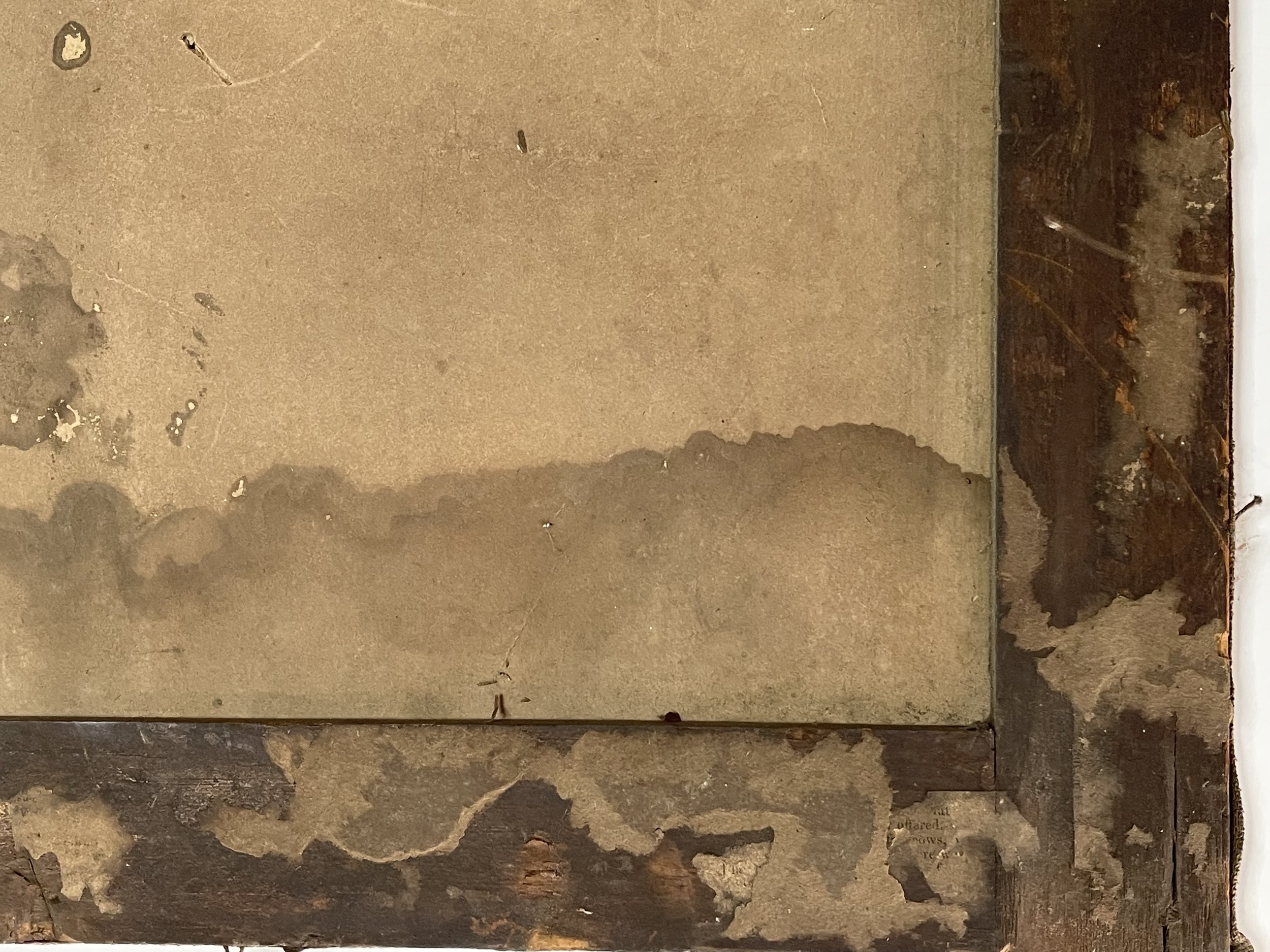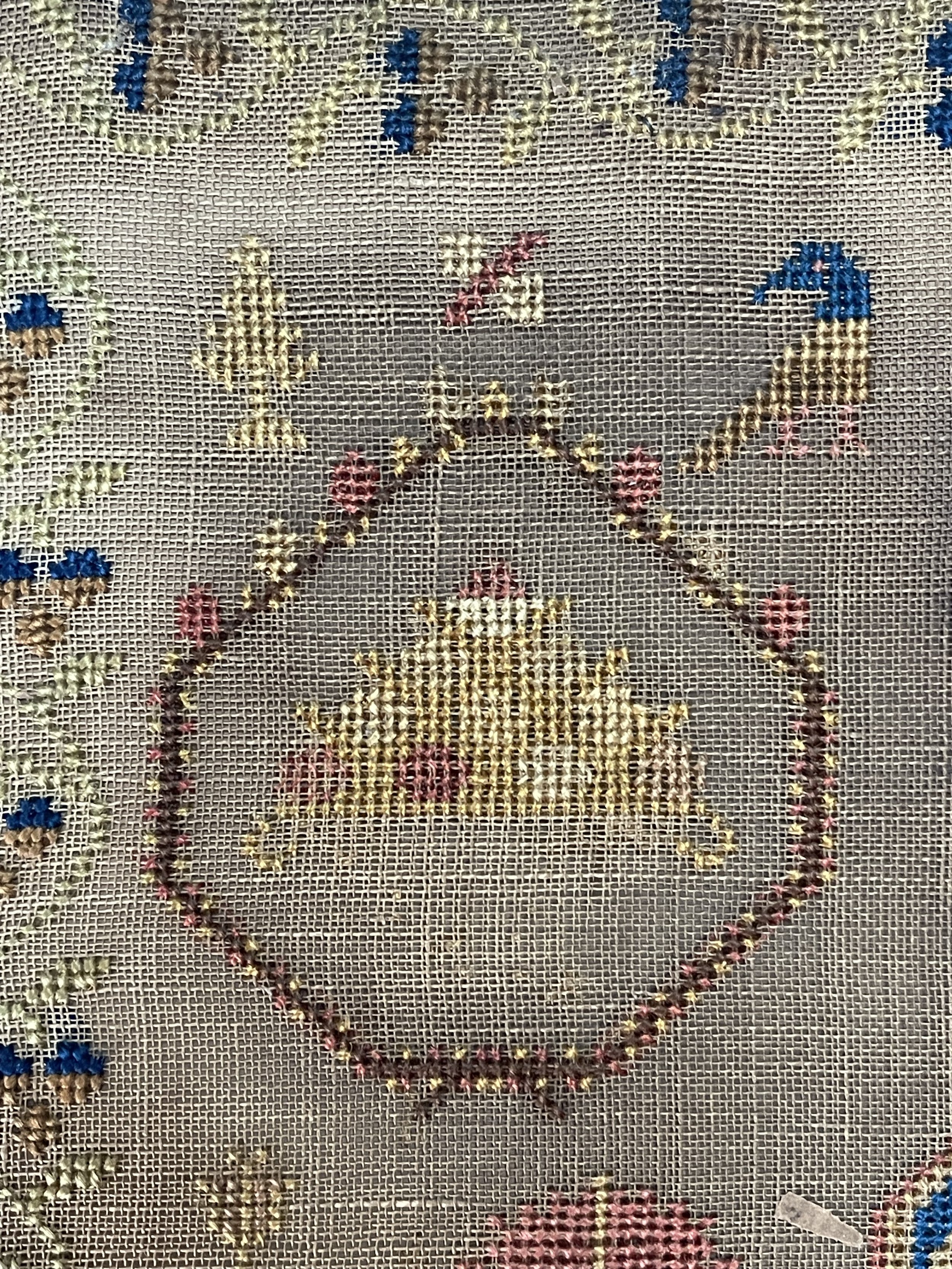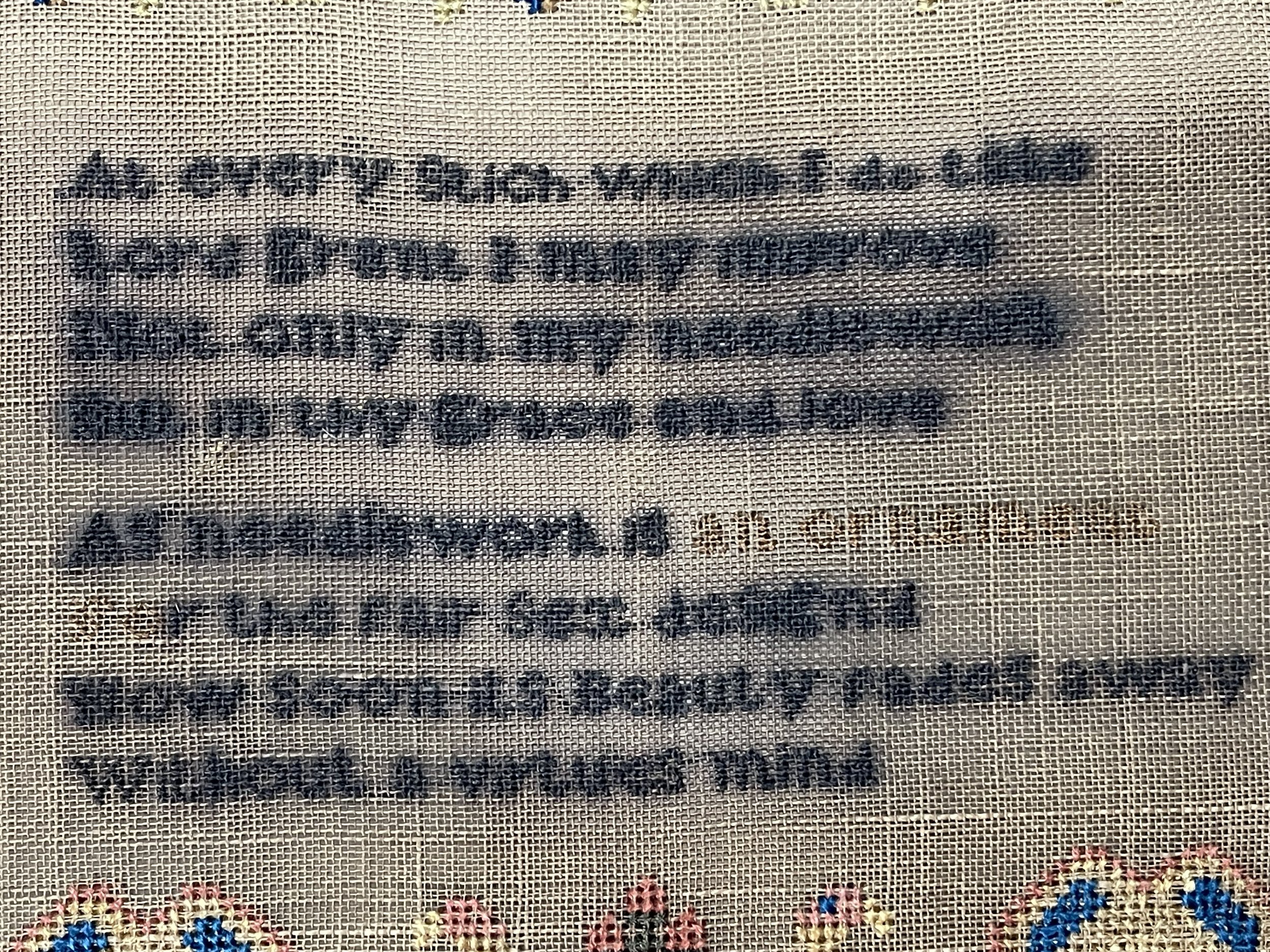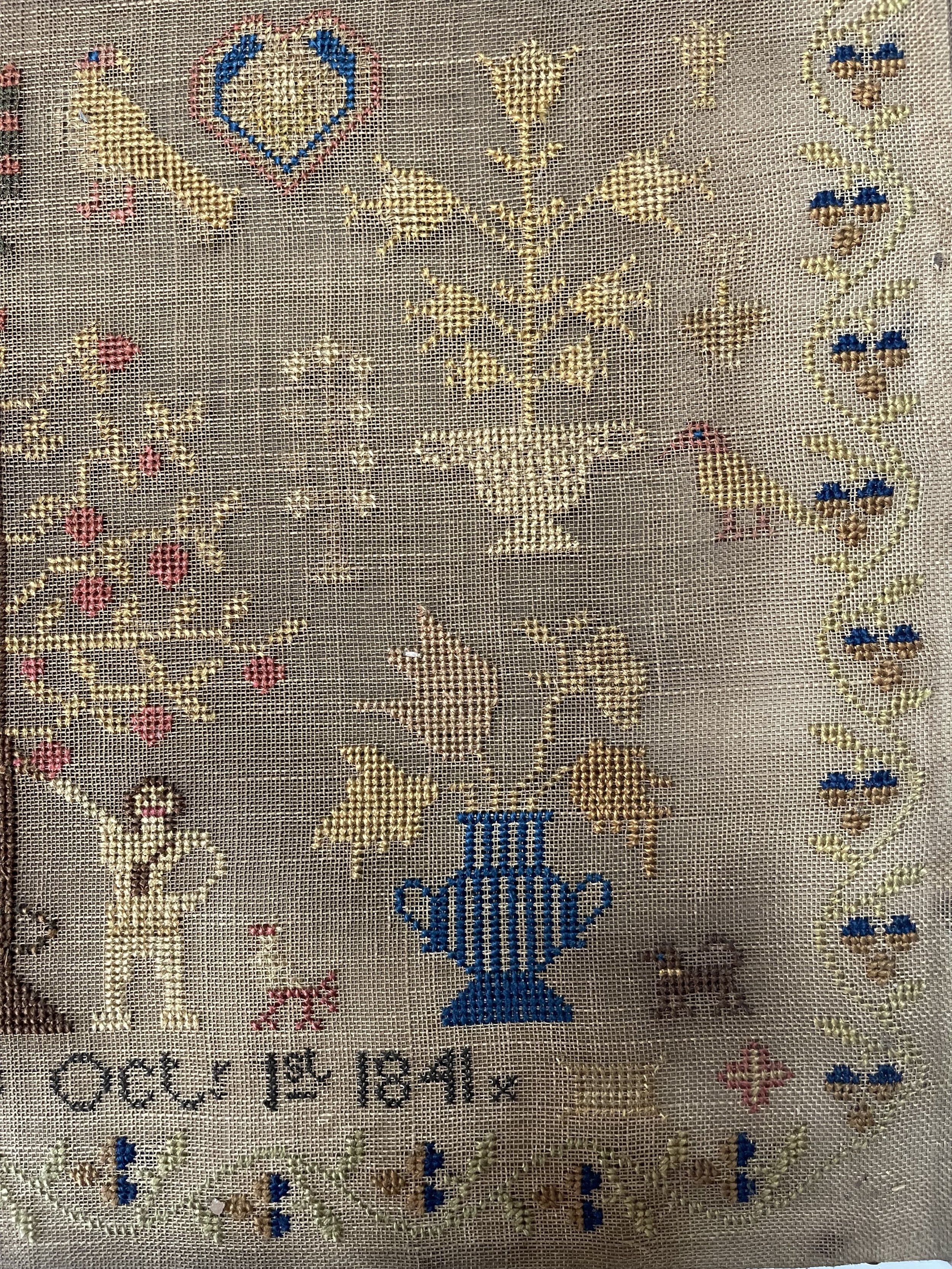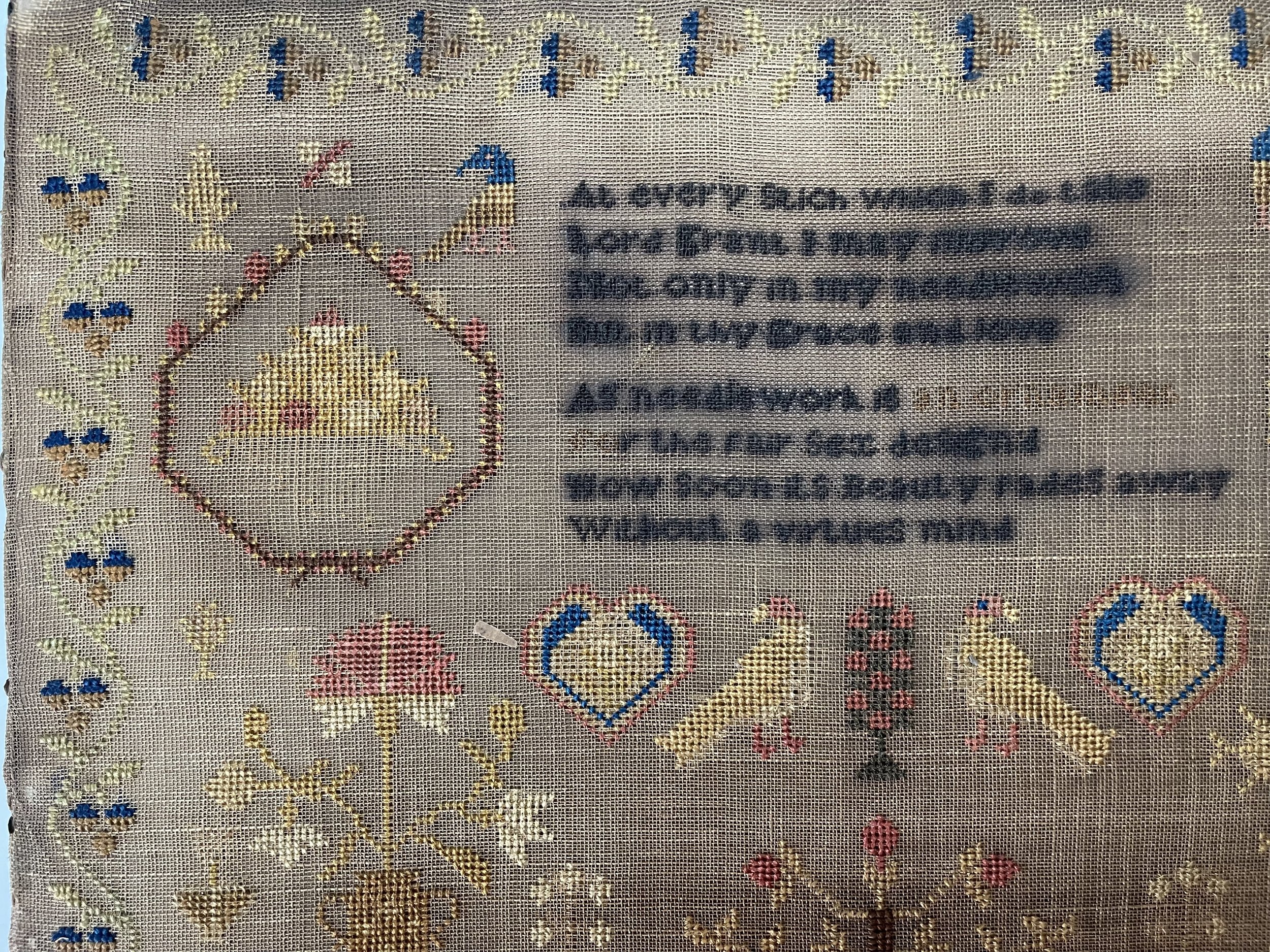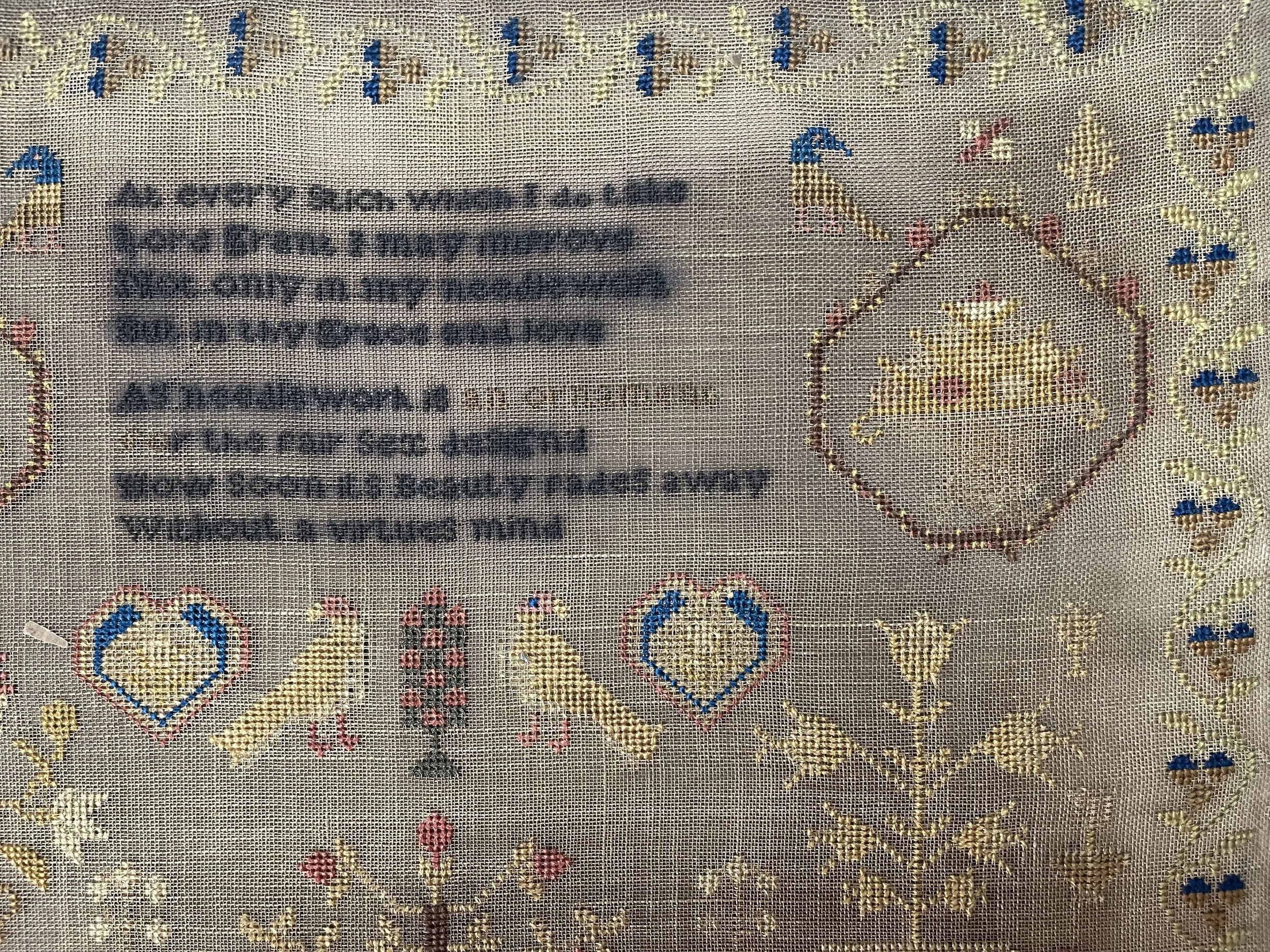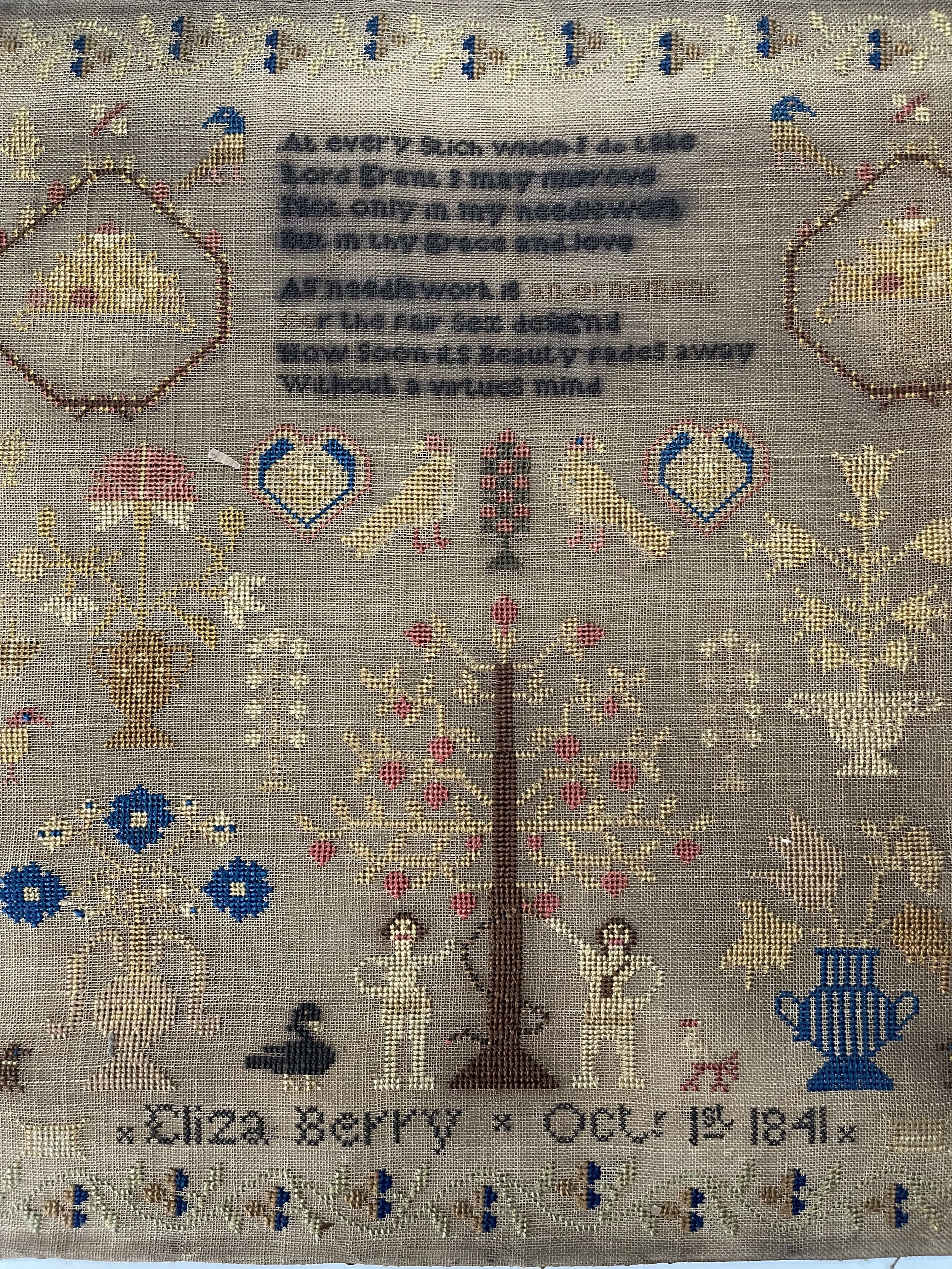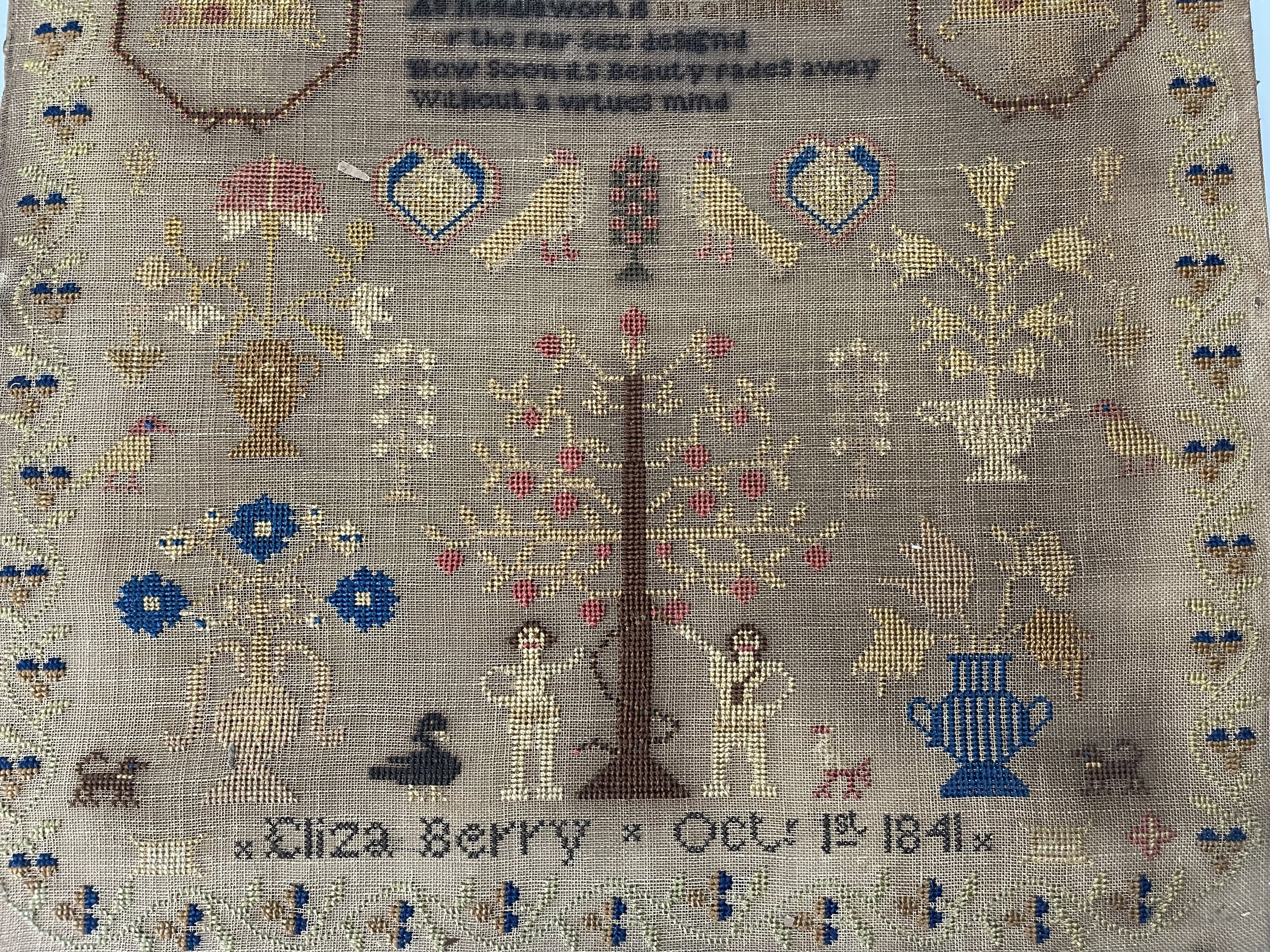English Antique Needlepoint Sampler - Eliza Berry - dated October 1st 1841
Antique Needlepoint Sampler - Eliza Berry - dated October 1st 1841
The Bible details how God's enemy, Satan, took the form of a serpent. He tempted Eve, then Adam, to eat the forbidden fruit with a false promise of getting even more than God had already given them. Adam and Eve gave in. They disobeyed God's only instruction.
In the Middle Ages and modern times, an apple represents overcoming original sin, often depicted as a snake with an apple in its mouth
The branch Adam holds is of the mountain ash, the Tree of Life, while the fig, of which Eve has broken off a branch, is from the forbidden Tree of Knowledge. Four of the animals represent the medieval idea of the four temperaments: the cat is choleric, the rabbit sanguine, the ox phlegmatic, and the elk melancholic.
Adam symbolises the "spirit of Adam", Eve symbolises "His self", the Tree of Knowledge symbolises "the material world", and the serpent symbolises "attachment to the material world". The fall of Adam thus represents the way humanity became conscious of good and evil.
Samplers have become very collectible and increasingly valuable to the collector. Traditional ABC samplers date back to 18th century orphanages where children learned cross stitch to practice stitches and alphabets and to acquire household skills that would be useful in service.
During the 1700s, samplers depicting alphabets and numerals were worked by young women to learn the basic needlework skills needed to operate the family household. By the late 1700s and early 1800s, schools or academies for well-to-do young women flourished, and more elaborate pieces with decorative motifs such as verses, flowers, houses, religious, pastoral, and/or mourning scenes were being stitched. The parents of these young women proudly displayed their embroideries as showpieces of their work, talent, and status.
In recent years, many of these samplers have been lost and have become important in museum collections as representations of early female education. Many are signed, and some are inscribed with locations and the names of teachers and schools. The emergence of these samplers has resulted in much research in diaries, account books, letters, newspaper ads, local histories, and published commentary that is helping to illuminate the lives of women.
Many early samplers do not have the letters “J” and “U” in their alphabets because they were not part of the early Latin alphabet and so the letter “I” was used for “J” and the “V” for “U.” The letter “s” is often replaced with the printer’s “s” which looks like the modern f.
Early samplers were stitched in wool, cotton or linen ( and occasionally silk) thread on plain linen. The colours are muted because they were produced using vegetable dyes, which fade or smudge over time. Later ones used commercially dyed threads.
Until the mid-1800s, all dyes came from natural sources, such as insects, roots, or minerals. Producing them was difficult and expensive. In 1856, an 18-year-old English chemist, William Henry Perkin, accidentally discovered one of the first synthetic dyes.
Cochineal was a favourite dye for red, scarlet, crimson, and oranges until about 1850 when synthetic reds were invented. Cochineal was a favourite because of its colourfastness, intense colour, and ease to process and work. During the eighteenth century, indigo was known as a universal source of blue, but there were different varieties.
The sampler depicts different animals. A cockerel, a duck, two dogs, two other birds in the midriff and at the top, two what looks like peacocks either side of another fruit tree. Around the periphery there is what seems to be a fig vine and there other gold cartouches, urns and vases that are possible more objects of temptation.
Eliza has worked some script at the top of the sampler that reads:
‘At every stich I do take Lord grant I may improve not only in my needlework but in thy grace and love as needlework is an ornament for the fair sex design’d how soon its beauty fades away without a virtues mind’
A beautiful sampler that would make a wonderful addition to any collection. The Sampler has its original backboard and I also have the original frame available - pricing upon request.
There is a label to the rear board that is complete and it reads: WM Jackson, picture framer and looking glass manufacturer, No1 Kensington Street, Derby. NB Barometer and thermometer manufacturer and repairer. Looking glass re-silvered on the shortest notice.
Pricing and grading commensurate.
Antique Needlepoint Sampler - Eliza Berry - dated October 1st 1841
The Bible details how God's enemy, Satan, took the form of a serpent. He tempted Eve, then Adam, to eat the forbidden fruit with a false promise of getting even more than God had already given them. Adam and Eve gave in. They disobeyed God's only instruction.
In the Middle Ages and modern times, an apple represents overcoming original sin, often depicted as a snake with an apple in its mouth
The branch Adam holds is of the mountain ash, the Tree of Life, while the fig, of which Eve has broken off a branch, is from the forbidden Tree of Knowledge. Four of the animals represent the medieval idea of the four temperaments: the cat is choleric, the rabbit sanguine, the ox phlegmatic, and the elk melancholic.
Adam symbolises the "spirit of Adam", Eve symbolises "His self", the Tree of Knowledge symbolises "the material world", and the serpent symbolises "attachment to the material world". The fall of Adam thus represents the way humanity became conscious of good and evil.
Samplers have become very collectible and increasingly valuable to the collector. Traditional ABC samplers date back to 18th century orphanages where children learned cross stitch to practice stitches and alphabets and to acquire household skills that would be useful in service.
During the 1700s, samplers depicting alphabets and numerals were worked by young women to learn the basic needlework skills needed to operate the family household. By the late 1700s and early 1800s, schools or academies for well-to-do young women flourished, and more elaborate pieces with decorative motifs such as verses, flowers, houses, religious, pastoral, and/or mourning scenes were being stitched. The parents of these young women proudly displayed their embroideries as showpieces of their work, talent, and status.
In recent years, many of these samplers have been lost and have become important in museum collections as representations of early female education. Many are signed, and some are inscribed with locations and the names of teachers and schools. The emergence of these samplers has resulted in much research in diaries, account books, letters, newspaper ads, local histories, and published commentary that is helping to illuminate the lives of women.
Many early samplers do not have the letters “J” and “U” in their alphabets because they were not part of the early Latin alphabet and so the letter “I” was used for “J” and the “V” for “U.” The letter “s” is often replaced with the printer’s “s” which looks like the modern f.
Early samplers were stitched in wool, cotton or linen ( and occasionally silk) thread on plain linen. The colours are muted because they were produced using vegetable dyes, which fade or smudge over time. Later ones used commercially dyed threads.
Until the mid-1800s, all dyes came from natural sources, such as insects, roots, or minerals. Producing them was difficult and expensive. In 1856, an 18-year-old English chemist, William Henry Perkin, accidentally discovered one of the first synthetic dyes.
Cochineal was a favourite dye for red, scarlet, crimson, and oranges until about 1850 when synthetic reds were invented. Cochineal was a favourite because of its colourfastness, intense colour, and ease to process and work. During the eighteenth century, indigo was known as a universal source of blue, but there were different varieties.
The sampler depicts different animals. A cockerel, a duck, two dogs, two other birds in the midriff and at the top, two what looks like peacocks either side of another fruit tree. Around the periphery there is what seems to be a fig vine and there other gold cartouches, urns and vases that are possible more objects of temptation.
Eliza has worked some script at the top of the sampler that reads:
‘At every stich I do take Lord grant I may improve not only in my needlework but in thy grace and love as needlework is an ornament for the fair sex design’d how soon its beauty fades away without a virtues mind’
A beautiful sampler that would make a wonderful addition to any collection. The Sampler has its original backboard and I also have the original frame available - pricing upon request.
There is a label to the rear board that is complete and it reads: WM Jackson, picture framer and looking glass manufacturer, No1 Kensington Street, Derby. NB Barometer and thermometer manufacturer and repairer. Looking glass re-silvered on the shortest notice.
Pricing and grading commensurate.
Antique Needlepoint Sampler - Eliza Berry - dated October 1st 1841
The Bible details how God's enemy, Satan, took the form of a serpent. He tempted Eve, then Adam, to eat the forbidden fruit with a false promise of getting even more than God had already given them. Adam and Eve gave in. They disobeyed God's only instruction.
In the Middle Ages and modern times, an apple represents overcoming original sin, often depicted as a snake with an apple in its mouth
The branch Adam holds is of the mountain ash, the Tree of Life, while the fig, of which Eve has broken off a branch, is from the forbidden Tree of Knowledge. Four of the animals represent the medieval idea of the four temperaments: the cat is choleric, the rabbit sanguine, the ox phlegmatic, and the elk melancholic.
Adam symbolises the "spirit of Adam", Eve symbolises "His self", the Tree of Knowledge symbolises "the material world", and the serpent symbolises "attachment to the material world". The fall of Adam thus represents the way humanity became conscious of good and evil.
Samplers have become very collectible and increasingly valuable to the collector. Traditional ABC samplers date back to 18th century orphanages where children learned cross stitch to practice stitches and alphabets and to acquire household skills that would be useful in service.
During the 1700s, samplers depicting alphabets and numerals were worked by young women to learn the basic needlework skills needed to operate the family household. By the late 1700s and early 1800s, schools or academies for well-to-do young women flourished, and more elaborate pieces with decorative motifs such as verses, flowers, houses, religious, pastoral, and/or mourning scenes were being stitched. The parents of these young women proudly displayed their embroideries as showpieces of their work, talent, and status.
In recent years, many of these samplers have been lost and have become important in museum collections as representations of early female education. Many are signed, and some are inscribed with locations and the names of teachers and schools. The emergence of these samplers has resulted in much research in diaries, account books, letters, newspaper ads, local histories, and published commentary that is helping to illuminate the lives of women.
Many early samplers do not have the letters “J” and “U” in their alphabets because they were not part of the early Latin alphabet and so the letter “I” was used for “J” and the “V” for “U.” The letter “s” is often replaced with the printer’s “s” which looks like the modern f.
Early samplers were stitched in wool, cotton or linen ( and occasionally silk) thread on plain linen. The colours are muted because they were produced using vegetable dyes, which fade or smudge over time. Later ones used commercially dyed threads.
Until the mid-1800s, all dyes came from natural sources, such as insects, roots, or minerals. Producing them was difficult and expensive. In 1856, an 18-year-old English chemist, William Henry Perkin, accidentally discovered one of the first synthetic dyes.
Cochineal was a favourite dye for red, scarlet, crimson, and oranges until about 1850 when synthetic reds were invented. Cochineal was a favourite because of its colourfastness, intense colour, and ease to process and work. During the eighteenth century, indigo was known as a universal source of blue, but there were different varieties.
The sampler depicts different animals. A cockerel, a duck, two dogs, two other birds in the midriff and at the top, two what looks like peacocks either side of another fruit tree. Around the periphery there is what seems to be a fig vine and there other gold cartouches, urns and vases that are possible more objects of temptation.
Eliza has worked some script at the top of the sampler that reads:
‘At every stich I do take Lord grant I may improve not only in my needlework but in thy grace and love as needlework is an ornament for the fair sex design’d how soon its beauty fades away without a virtues mind’
A beautiful sampler that would make a wonderful addition to any collection. The Sampler has its original backboard and I also have the original frame available - pricing upon request.
There is a label to the rear board that is complete and it reads: WM Jackson, picture framer and looking glass manufacturer, No1 Kensington Street, Derby. NB Barometer and thermometer manufacturer and repairer. Looking glass re-silvered on the shortest notice.
Pricing and grading commensurate.
Code : A643
Cartographer : Cartographer / Engraver / Publisher: Eliza Berry - October 1st 1841.
Date : Publication Place / Date - 1841
Size : Sheet size: approx 44 x 44 Cm
Availability : Available
Type - Genuine - Antique
Grading B+
Where Applicable - Folds as issued. Light box photo shows the folio leaf centre margin hinge ‘glue’, this is not visible otherwise.
Tracked postage, in casement. Please contact me for postal quotation outside of the UK.


